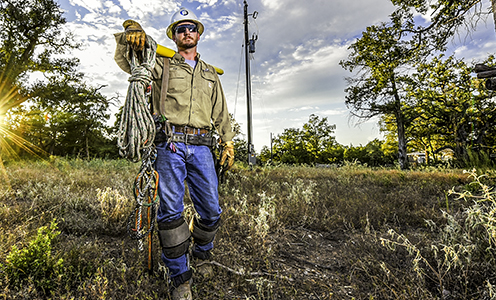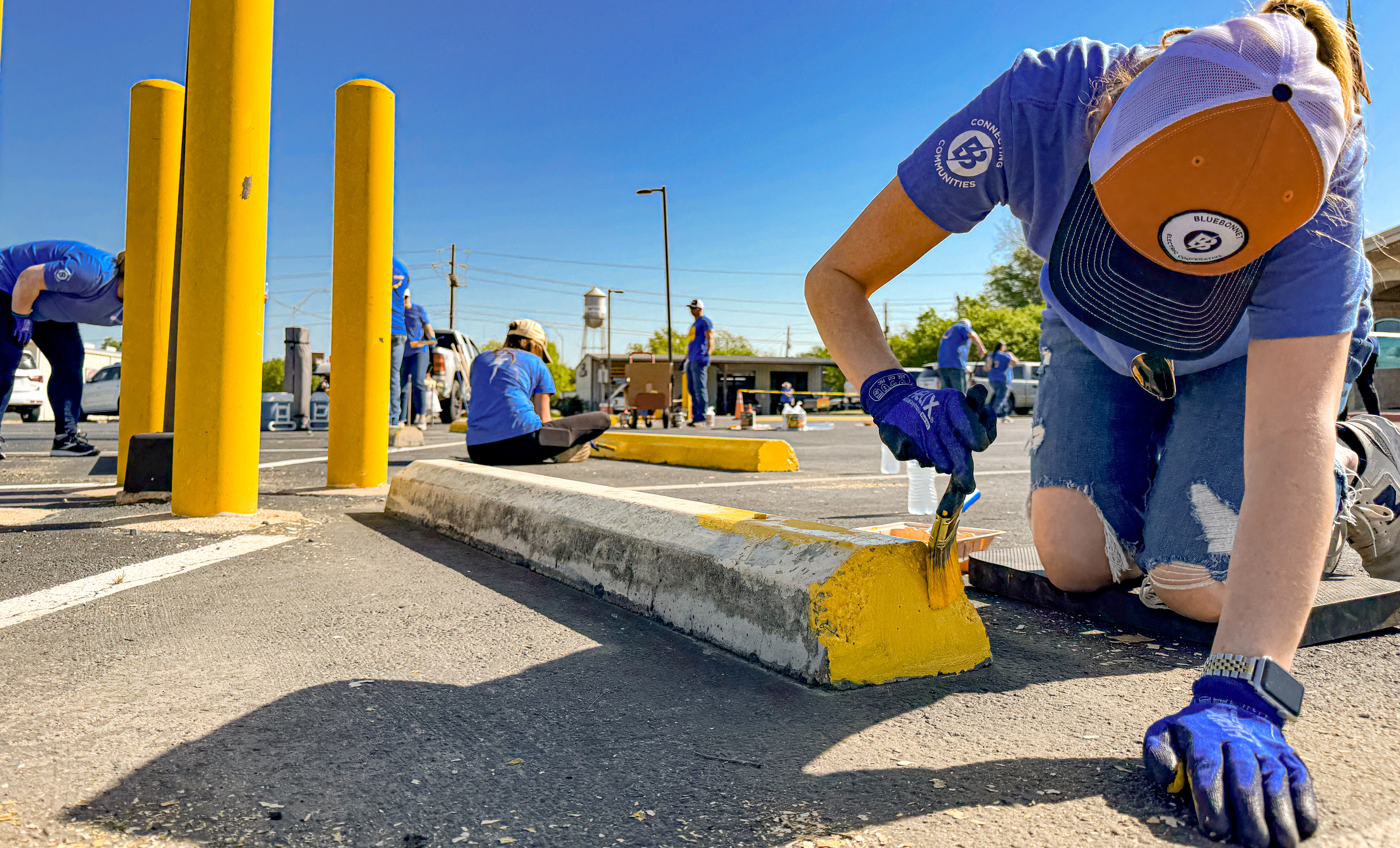First responders of the Bluebonnet region
Recent news
The Tesla backup switch — designed to simplify installation of the company’s Powerwall solar battery storage system — was tested by Bluebonnet Electric Cooperative in 2021.
Bluebonnet reviewed the device for use in conjunction with Bluebonnet meters. It switches automatically between using stored renewable electricity and Bluebonnet-distributed electricity. Bluebonnet approved the backup switch for use on its system last year.
The use of the backup switch cuts Powerwall installation time from 10 hours to about one hour by avoiding the need to extensively rewire the connection from a home's breaker panel, according to Tesla’s website. Since October 2021, every Tesla Powerwall whole-home backup system (which costs $11,500 before installation) comes with a Tesla backup switch.
The switch also provides greater safety to Bluebonnet’s line workers. If a power outage is detected, the switch automatically disconnects the battery-stored electricity from Bluebonnet’s lines. That prevents the stored power from being pushed back onto the lines, keeping line workers who are restoring power safe.
Licensed electric battery storage installers can find specifications for installing Tesla backup switches here.
That humming sound you hear might be the electric vehicle market buzzing all around Central Texas. Many automakers have added at least one all-electric vehicle model to their fleets and have plans to sell more electric vehicles than gasoline-powered ones by 2040.
Tax credits available under the recently enacted federal Inflation Reduction Act add incentives to electric vehicle purchases in the next few years. Although there are requirements about household income and sales prices, people who buy a new electric vehicle may be eligible for a tax credit worth up to $7,500, and one up to $4,000 for used vehicles.
Some of those vehicle details can be found at the Alternative Fuels Data Center website, at afdc.energy.gov/laws/inflation-reduction-act.
If you’re thinking about buying an electric vehicle, or EV, you’re probably thinking a lot about how to charge its battery.
While a lot of electric vehicles can be charged using a common 120-volt wall outlet, that is probably going to be a slow process. Many electric vehicle owners opt to install a level 2, 240-volt charger, which can charge an EV two times quicker than an ordinary electric outlet.
A Kia EV6, for example, can charge to 100% after a 50-mile commute in 1½ hours. This would cost a Bluebonnet member $1.60 with a level 2 charger at home. It would take nearly 12½ hours to charge that same Kia with a regular 120-volt wall outlet. Though you can charge the vehicle relatively quickly at level 2, it’s recommended that EVs be charged overnight, not during the day.
Good news: Retrofitting your garage with an electric vehicle charger is easier than you think.
First, consult an electrician on whether your home has adequate electrical capacity for a vehicle charger. Some homes might not be able to power level 2 equipment. However, a qualified electrician can add circuits to accommodate the capacity needed for level 2 charging. The average cost in 2021 to install an outlet for a level 2 vehicle charger was $750, with costs varying by your location and your home’s electric wiring.
Chargers can be purchased separately from your vehicle’s manufacturer, home improvement store or through an online retailer, and costs vary. Some manufacturers, such as Chevrolet, include a level 2 charger with an electric vehicle purchase.
Some electric vehicle owners opt to charge their EV using the outlet for their home’s clothes dryer. It’s the same 240-volt outlet required for a level 2 charger.
Once a 240-volt outlet is installed, electric vehicle owners can mount a 10- to 15-pound level 2 charger on the wall near the 240-volt outlet and plug it in to the new outlet. Many automakers sell home charging stations for an additional fee with your electric vehicle, but you can also purchase an Energy Star home charger online at energystar.gov/products/other/ev_chargers.
If you’re on the road and need a charge, high-powered commercial charging stations can power up that same Kia EV6 for 100 miles with a level 3 fast charger in 8 minutes. Getting that same charge for the Kia from a level 2, 240-volt home charger would take 3.5 hours, or 26.5 hours with a level 1, 120-volt charger.
Story by Addie Broyles
Photos by Laura Skelding

This year, it started with grasshoppers.
The insects came in droves a few months ago, stripping the leaves off peach trees at Ward and Jill Taylor’s farm outside Lexington in Lee County. “They left the peaches dangling off like a Charlie Brown Christmas tree. Then they came and ate the peaches and left the pits. Now they are eating the bark off the trees,” Ward Taylor said.
That was only the beginning. “It’s been brutal,” Ward, 61, said of the damage that this summer of 2022 has brought to the couple’s 40-acre Taylor’s Farm. Twelve years ago, Ward and Jill bought the land because they shared a dream of farming — growing squash and tomatoes during Texas’ typically long growing seasons.
The reality, especially in the last few months, has been closer to a nightmare.
On the heels of a two-decade boom, many small farms in the Bluebonnet Electric Cooperative service area and across the state – often run by farmers with less than a decade of experience – are facing serious troubles.
Weather-related disasters, from a prolonged freeze to this year’s record-breaking heat and drought, have caused severe damage to many small farms. Rising prices, unstable supply chains and labor shortages are adding to farmers’ problems. Many of them are doing what they can to keep going. Those with more experience often diversify their operations to maintain their livelihood. Others relatively new to farming have slowed or shut down operations.
This isn’t the Taylors’ first brush with drought. They’ve been farming here since 2010, starting just before the state’s last historic drought in 2011. Despite the struggles, the couple do not regret leaving their jobs as Boeing employees in Washington state. Ward worked in programming and design there for nine years, and Jill worked in finance for 20 years. They came to the Bluebonnet area to join the wave of new farmers who were setting up shop in Central Texas during the beginning of the locavore, or “eat local” movement of the 2000s.
“Our first year here, our pastures were blowing dust and dirt, and we couldn’t find hay anywhere for the cows,” Ward said. “I remember thinking that if this goes on for any longer, we are going to have to sell our cows off.” But that drought lifted, and the Taylors started what became a thriving farm, raising cattle, pigs and lots of vegetables, enough to feed several hundred families. They sold their produce mostly at Central Texas farmers markets and to area wholesalers.
They, like the majority of small, family farms in the region, use sustainable and organic practices in their farming. Their business peaked after the COVID-19 pandemic started, when the demand for local food was high. Nearly every small farm in Texas had a wait-list for their community supported agriculture program, which lets customers buy a share of a farm’s harvest in advance and receive direct delivery of the food. This allowed the Taylors and other area farmers to sell through new channels. Then the weather started to shift. Again.
“In the 12 years we’ve been here, we’ve had four of the top 12 hottest summers since they’ve been keeping records,” Ward said. The Taylors recently sold their bull to save on feed costs. They stopped going to farmers markets earlier this year and, instead, launched a new farmland leasing program, where beginning farmers could grow their own crops, protected under plastic-covered structures.
This summer’s harsh conditions drove those beginners away, and only a handful of people are interested in the lease opportunity as of early August. “It’s getting bleak for small farmers, that’s what it comes down to,” Ward said. “When the weather’s bad, field prices (the costs of growing) are bad, supplies are short and prices are high. It’s been one thing after the next and all at the same time now.”
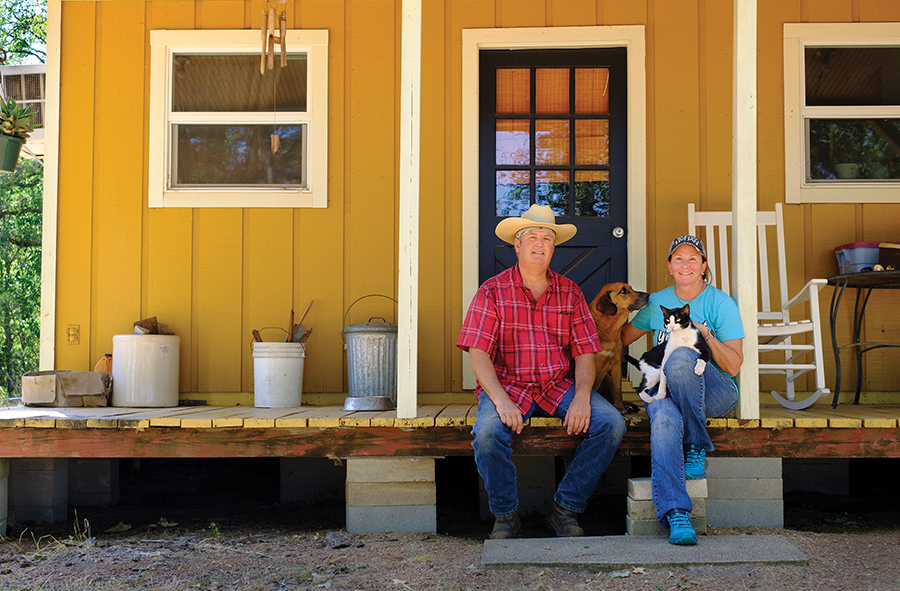
The Texas breadbasket
A 2017 report by the Texas Department of Agriculture showed that of the nearly 250,000 farms and ranches in Texas, about 77,500 are operated by producers with fewer than 10 years of experience.
A quarter of new and beginning farmers are under the age of 35, and the number of female farmers has increased almost 70 percent since 2012. That report found the average farm size at the time in Texas was 411 acres, and the average age of farmers/ranchers was 59.
The swath of Central Texas between Austin and Houston is home to hundreds of miles of rich farmland, but the extreme weather of more than a decade could be the new normal for farmers.
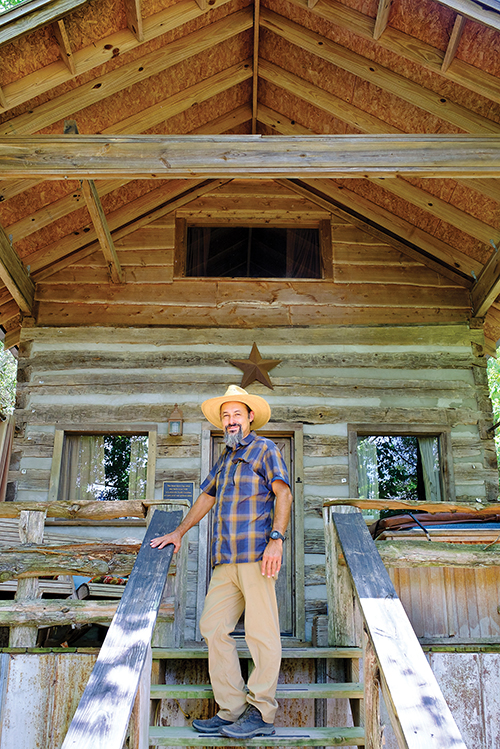
“This was the original breadbasket of Texas,” said Brad Stufflebeam, who, along with his wife, Jenny Stufflebeam, started their 12-acre Home Sweet Farm near Brenham 22 years ago. The couple searched the river basins of Central Texas for more than two years before buying their land in 2004.
They dove straight into production vegetable farming, growing crops you’d find in the grocery produce section: leafy greens, carrots, melons and squash. After serving in the U.S. Navy, Brad studied horticulture, started a nursery with Jenny and learned about farming as the head of operations at World Hunger Relief, a farm-based program in Waco.
The organization addresses issues of global food insecurity and malnutrition. At its farm, about 6,000 high school students visit each year. Brad learned that when people first step onto farmland, and see how food is grown, farming can have a powerful allure. Unlike the Taylors, who built up their customer base through farmers markets, the Stufflebeams formed a partnership with about 20 other farmers in the area to build the Home Sweet Farm community-supported agriculture program that served the Houston area for more than a decade.
At one point, the program had nearly 400 subscriber families and a two-year waiting list. But after the 2008 recession and 2011 drought, farmers took a hit. Then grocery stores and delivery services started offering home produce delivery. “After the drought and Hurricane Harvey (in 2017), most of them threw in the towel,” Brad, 51, said. Growing vegetables and producing dairy is what Brad calls “intense farming.” “If it was easy and profitable, everybody would do it. There’s a reason our state is best suited for cattle,” he said.
According to the state’s agriculture department, in 2017 slightly more than half of the state’s agricultural market value was in cattle: $12.3 billion compared to only $352 million in fruits and vegetables. The Stufflebeams got creative about their revenue stream. In 2014 they opened Home Sweet Farm Market & Biergarten in downtown Brenham, the seat of Washington County. They sold that business in 2021 to focus on other new projects. Today the Stufflebeams have a dozen short-term private cabin rentals and give farming workshops, which Brad calls “agritainment.”
They’ve added higher grossing, less labor-intensive perennial plants to their lineup, including tea. They are currently testing varieties. To shield their crops from 2022’s weather, they installed tunnel-like covered structures that protect plants from harsh weather. Earlier, they had dug new 480-foot-deep water wells.
“That saved us,” Brad said, “but even now, we’ve lost a couple of cows this year.” In late July, an older water well on the property went dry for the first time in 50 years. Farming is a long-term investment, he said, which is why a multi-generational farm has an advantage. “The infrastructure is still there. New farmers have to start from scratch.”
Connecting young farmers in Central Texas
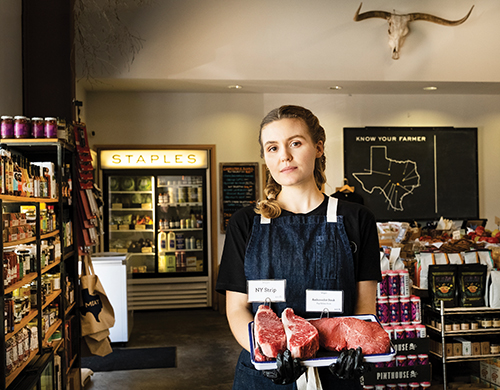
Although farmland wasn’t cheap 15 years ago, prices for rural real estate in the Bluebonnet region have shot up in the last few years, said Hayley Wood, an aspiring farmer and director of the Central Texas Young Farmers Coalition, an organization aimed at building collaborative, diverse farming communities.
Wood, 27, is among many who struggle to find arable, affordable farmland these days. Wood grew up in San Antonio but caught the farming bug while working in Latin America.
After returning to Texas, she looked for ways to get experience. She apprenticed at Urban Roots and Community First Village, two community organizations in East Austin that use agriculture as a way to bring people together and teach life skills to young people and individuals who have experienced homelessness.
Wood recently worked at Steelbow Farm, a mixed vegetable farm in Manor on land that, for 25 years, was home to the 15-acre Tecolote Farm. That farm’s founders, David Pitre and Katie Kraemer Pitre, were among the 1990s wave of new farmers in Central Texas who helped create the locavore movement encouraging diners to buy and eat locally produced food.
When the Pitres retired a few years ago, they leased half of their farm to Finegan Ferreboeuf and Jason Gold, who named their business Steelbow Farm.
The Tecolote owners sold the other half of their farm, a separate parcel of land on the Colorado River, to longtime employee Lorig Hawkins. That land is now Middle Ground Farm, but this summer’s drought has brought a pause in activity there for the fall season.
The heat and drought claimed Wood’s farm job, so she started working at Salt & Time, an East Austin butcher shop and restaurant. She also hopes to learn about the business of cattle there while waiting out the harsh weather and economic conditions.
Wood still volunteers 10 to 15 hours a week advocating for young and beginning farmers through the coalition. Every farm is different, she said, but every farmer is just trying to make it to the next season.
Many years ago, it was almost a given that a farmer’s children would take over the farm, but that isn’t the norm today. Nebraska-based Farmers National Company, the country’s largest agricultural landowner services company, predicts that 70 percent of U.S. farmland will transfer ownership in the next 20 years.
“Farming can feel disconnecting in ways that other professions don’t,” Wood said. “It’s essential for farmers to hear from one another. It’s critical that they know they aren’t alone. State resources help, but what is lacking is that peer-to-peer connection.”
The young farmers coalition started in 2013 as a way for new farmers to network through potlucks and educational events. The coalition addresses issues as varied as farm advocacy and mental health. It serves eight counties, including Bastrop, Caldwell, Hays, Travis and Guadalupe, all or parts of which are in the Bluebonnet service area. Although it targets farmers younger than age 45, Wood said, “it’s not about how old you are; it’s about where you want to go and the path that you’re on.”
The Texas Department of Agriculture offers Young Farmer matching grants of $5,000 to $20,000 for people ages 18 to 45. The coalition encourages farmers to look at agriculture through a racially inclusive, community-building lens to make farming careers accessible to everyone. Other organizations such as the National Center for Appropriate Technology and the Bryan-based Texas Small Farmers & Ranchers Community Based Organization reach out to Black, Hispanic, women and military veterans who are beginning farmers and need additional support.
Ryan Farnau is another proponent of farming partnerships.
This year’s drought was hurting his crops, but he had to give up F-Stop Farm, his three-quarter-acre plot in Manor, when the land was sold to developers. Farnau had leased the small corner of a ranch in eastern Travis County for three years, but he started selling produce from his backyard garden in 2013.
His involvement with community-supported agriculture followed in 2014 when he sold his okra, onions, tomatoes and other vegetables at farmers markets and to area chefs.
“The last two seasons have been the hardest growing seasons in memory,” he said. “It’s a bittersweet thing for me to walk away, but I’m committed to being part of the food system.”
Farnau, 50, a father of two children, moved to the Austin area in 2010 from Kentucky by way of California, where he worked as a photographer. He plans to continue making and selling products such as pickles and kimchi, the traditional Korean dish of spicy, fermented vegetables. He is also writing a business plan for a private-public partnership farm with mixed-use development around it.
“Agriculture has always been and will always be a partnership,” he said. “No matter what size of farm, you need other people. If it’s not your father or your brother or your children, you need other people.”
Farnau is working with regional food vendors to prepare foods in their commissary kitchens, which would allow him to sell in area grocery stores and markets. He continues to meet people who want to get into agriculture, particularly millennials disaffected by other careers.
“I don’t want to be Chicken Little about it, but the food system is going to break, and if we don’t build agriculture centers near urban centers, people aren’t going to be able to go to the grocery store and get what they need. We need to remember that we are organisms in an ecosystem, not consumers in a marketplace,” Farnau said.

New ways to keep small farms going
Jill and Ward Taylor aren’t interested in fully retiring or leaving their Lexington property, but their three children aren’t planning to take over the business. In 2021, when they announced plans to lease some land to small-scale farmers, three people expressed interest within a few days.
One of them was Jane Watiri-Taylor, a Kenya-born former nurse who left her job in early 2022 at the Travis County Jail to commit to full-time farming. In March of this year, she was one of several people profiled in a New York Times story about post-pandemic career changes. Watiri-Taylor, who is unrelated to the Taylors, had enrolled in Farmshare, a nonprofit that educates new farmers at a farm in Cedar Creek in Bastrop County. More than 75 students have taken Farmshare’s beginner’s course since 2014, and about a dozen have gone on to start their own farming operations. At Taylor’s Farm, Watiri-Taylor leased one of the tall, protective structures and sold her produce at farmers' markets under the brand Green Thumb Farming. She has since given up her lease, though, and now grows at a community garden near her home in Pflugerville. She sells at an area farmers market.
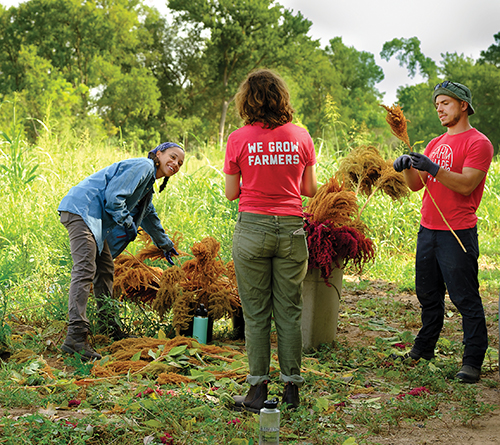
“She has a realistic view of what it takes to do this,” Ward Taylor said. “But that’s farming for you.”
Connecting with other farmers has been an invaluable asset to Taylor’s Farm in the past decade. “All the cards are stacked against small farmers,” Ward Taylor said. “If people can see the synergy of working together, like buying seed potatoes in bulk or helping out with transportation of feed, we can grow that coordination.”
The pandemic underscored the importance of cooperation.
Although many farmers markets continued operating under strict COVID protocols, other farmers, including the Taylors, shifted to selling through websites like Farmhouse Delivery, MilkRun and a service called Barn2Door, which allowed them to host e-commerce on their own website, taylorstxfarm.com.
This year the Taylors have faced new challenges, from grasshoppers to drought to supply price hikes.
There are other downsides to growing vegetables besides the weather. It can be big business, but a lot of people start and then shut down after a few years. New farmers often “don’t realize how much work it is until they get into it,” Brad Stufflebeam said. “It’s either that, or they find a way to make it sustainable,” he added, by using wholesale accounts, farmers markets or direct-to-consumer deliveries.
“Vegetables can bring in $28,000 per acre,” he said, although labor and fertilizer costs eat into that profit. Picking 800 pounds of tomatoes one day and getting them to market the next is an exhausting amount of work. With this summer’s extreme heat, drought and added competition from grocery stores and delivery services, it’s even harder for area farmers to compete. “In Austin or Houston, you can sell a $5 tomato,” Stufflebeam said, but a buyer in Brenham might balk at that price.
Contrast that with the much lower cost of raising cattle – several hundred dollars per acre, on average – and growing produce can start to look like too much work for the investment. “I’d look out at these 12 acres every year, and it looked gorgeous, but every three months I had to dig it in and plant it again,” Stufflebeam said. Wood, of the young farmers group, says that the numbers of new farmers ebb and flow every decade, as new people enter the industry and others exit or change their business model.
“There’s been a big surge of people saying farming is cool, but it’s a complex issue,” Wood said. “There’s a lot of assumption about how easy it is, or that it’s just about growing food and being outside. But the truth is that people want work that is tangible and is meaningful and is shaped around interconnectivity. “I don’t ever discourage people from getting into this field, but I encourage them to think about what they want to get out of farming and to be open-minded about what they might get out of it.”
***
Helpful farming resources
For secure browsing, type https:// before each of these website URLs.
farmers.gov/protection-recovery
farmers.gov/protection-recovery/drought
farmers.gov/loans and its Farm Loan Discovery Tool linked from that page
lulingfoundation.org agriculture demonstration farm offers in-person education, varied crop operations, demonstrations
droughtmonitor.unl.edu to track drought information on the U.S. Drought Monitor
fsa.usda.gov/state-offices/Texas for statewide information and resources
tsfrcbo.org/resources from the Texas Small Farmers & Ranchers Community Based Organization
texashelp.tamu.edu to browse the Texas A&M AgriLife Extension Service’s Disaster Education Network
agrilifeextension.tamu.edu/browse/program-areas for a variety of departments, programs and units available to farmers and ranchers through the A&M AgriLife Extension Service
***

AN INCREASE AT AUCTION
An increasing number of cattle are being brought to auction across the state, including these, above, at the Lexington Livestock Commission auction July 23, said co-owner Steven Heller. His family has owned the commission since 1956 and he has worked there since he was a kid. About 1,500 to 1,900 cattle are being brought to auction every week this summer, Heller said, compared to the typical 800 to 1,000. ‘‘People are selling because it’s so dry,’’ he said.
Feeding cattle has become more difficult and expensive as the drought wears on. Both experienced and newer farmers are being forced to sell more cattle than is typical. ‘‘The heat and dry weather, it’s one of the worst in the last 50, 60 years,’’ said Victor Yurk, who was selling calves at the auction in July. ‘‘We normally don’t sell calves under 600 pounds, but we’re selling calves that are 450 (lbs.).’’
The level of ‘‘cow herd liquidation’’ in Texas and across the nation this summer hasn’t been seen since the 2011 drought, according to David Anderson, Texas A&M University professor and extension service economist for livestock and food marketing, in a July interview with the Texas Farm Bureau. The cost of raising calves has also increased, he said, predicting a 4% decrease in America’s cattle herds in the next year.
***
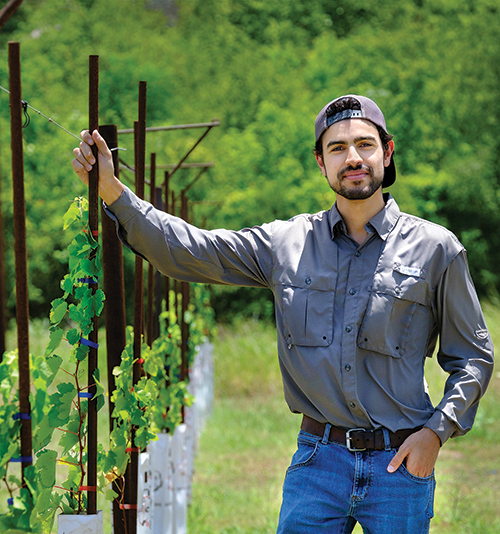
INSIDE LOOK
Andalucian Ranch Texas
Where: Bellville, in Austin County
Started: 2018
Size: 200 acres
Owners: Youssef and Giovana Bargach
From: Born in Morocco
What they grow: Grapevines (for wine) and cattle
What they tried to grow: Olive trees. Youssef and Giovana had just finished planting 5,000 olive trees the summer before the 2021 statewide freeze. Every tree died. “I’m stubborn as an ox when it comes to these things, so I purchased 100 (grape)vines for this year and planted them,” Youssef said. “If they take off, then it’ll be a much slower project. It’s a turbulent story. I grew up on a farm in Morocco that was self-sustaining, but once you come over here, things have to be profitable. They can’t just be self-sustaining.”
Advice for the new farmer: “The best thing that I could tell anybody is to start small and build up at a reasonable pace,” Youssef said. “I underestimated how quickly I could burn out.” A new farmer can start with less than 25 acres, he said.
***
INSIDE LOOK
Small Town Farm
Where: Fentress, in Caldwell County
Started: 2019
Size: 1 acre
Owners: Miguel Guerra and Cristen Andrews
From where: Originally from Eagle Pass and Pflugerville, respectively, the former Austinites started looking for land in Fentress along the San Marcos River more than a decade ago.
What they grow: Herbs, native plants, vegetable transplants, which they sell at the San Marcos Farmers Market, along with value-added products like chai-spiced honey and lemongrass tea.
What they tried to grow: Vegetables for the farmers market, which they tried for a year. ‘‘There was no way we could keep doing that,’’ Andrews said.
***
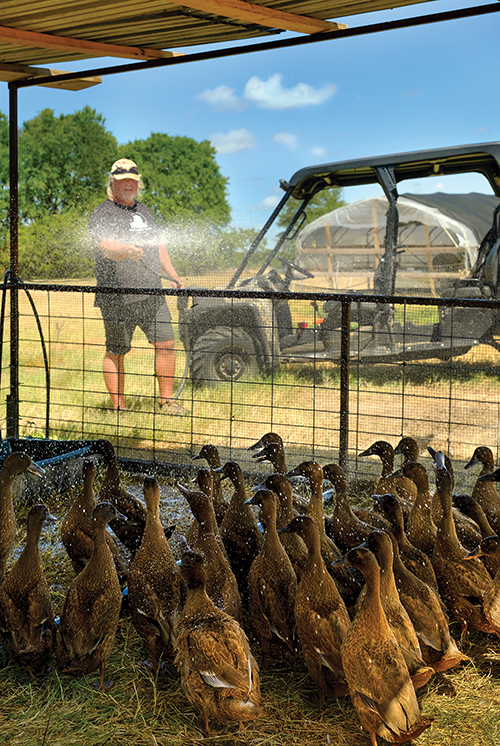
INSIDE LOOK
Whitehurst Heritage Farm
Where: Brenham, in Washington County
Started: 2017
Size: 57 acres
Owners: Michael and Leslie Marchand
From: Started in Cypress, northwest of Houston, in 2014
What they grow: Vegetables for community-supported farm-share boxes, eggs, poultry, pork and cold-pressed juice
What they tried to grow: Meat chickens and turkeys; the Marchands are cutting back the number of animals to a manageable level.
Advice for the new farmer: “Go on YouTube and start watching videos,” Michael Marchand said. “There is so much that is there for the beginning farmer. But if you’re someone who wants to raise a family and do it as your primary business, you need to buy some professional farmers (education) courses for about $2,000 each. Those can take you from knowing nothing to a decent level of skill in a few months. You can also pay a professional farmer to coach you.”

